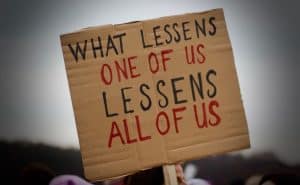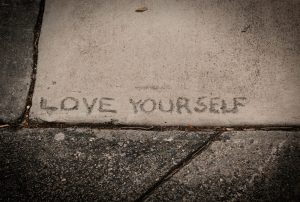Stigma can take many forms.
It can be uninformed beliefs, judgment, name-calling, labeling, or images. It can be in your face, or so subtle you are unsure if it actually happened. Stigmatizing language or behavior makes it very clear that there is a difference between “us” and “them” – and it’s negative.
It permeates our lives, whether it’s targeted at ethnicity, race, gender identity, age, disability, poverty, weight, or anything else. Stigma contributes to health issues, silence, isolation, and discrimination. Mental health challenges need treatment, we don’t just “get over it.” Substance use disorder is a disease, not a moral failure. Ultimately, stigma and shame is a barrier to getting treatment, support, and equity.

Types of Stigma
Public or societal stigma is when stereotypes, prejudice, or discrimination are directed at a specific group by the larger population.
Self-stigma is when you internalize negative beliefs about your health challenges. Stigma profoundly changes how we feel about ourselves: whether feeling inadequate, ashamed, or having low self-esteem.

How can we respond when faced with public stigma?
Whether it’s directed at you or directed at others, here are a few tips that can help:
- It’s up to you whether you want to correct the other person by sharing your personal experience or reply in a more general manner. That said, you never have to tell your personal story.
- When you are armed with facts about stigma about any issue, you are in a better position to respond to others when they convey false information. As an example, if you hear or read stigmatizing language people with substance use or mental health challenges, you will be better prepared if you learn about the science and challenges of both.
- Don’t know what to say in response? Try using a stigma interrupter to get their attention:
-
- What you just said is not okay with me (or is harmful, offensive, hurtful.)
- I never knew you thought that about addiction (or mental health, race, disability, or other issue.) Help me understand why you believe that.
- I don’t like how you just described people with depression (or any other issue.)
- That’s not funny.
- I’m disappointed to hear you say that.
- This conversation is making me uncomfortable.
Wake up everyday and choose yourself. Other people are not entitled to all the details of your existence. Your existence is for you first, so enjoy it.Lessons Learned

Our inner voice can often be our most harsh critic.
When it’s fed by public stigma, discrimination, negative messages, or a lack of self-esteem, the voice of self-stigma gets louder and louder.
- Learn more: The more you know about it — weight, mental health, racial disparity, or anything else — the more you will understand about yourself.
- Self Talk: When you are focused on what you don’t like or hate about yourself – try replacing those stigmatizing words with the word “understand.” Instead of what you don’t like about yourself, instead, focus on what it is that you don’t understand about yourself.
- Open Up: Seek therapy or support groups to talk about unresolved feelings.
- Check Yourself: when you are feeling guilt or bad about yourself, you actually lock yourself into that space.
- Reach Out: some people said that getting involved in advocacy or volunteer work to fight stigma helped improve their own self-esteem and created a network of support.
It can be hard to respond to another person or an entity when we hear them say or share stigmatizing or hateful thoughts or words — whether they are aware that it’s hurtful or not.
Next, people who have experienced stigma share what lessons they’ve learned and what works for them when dealing with stigma.
LEARN MORE:
SAFE: What No Shame Means to Me
VA: Ending Self-Stigma for Veterans
NAMI: The Many Impacts of Self-Stigma
CDC: COVID-19 and Reducing Stigma
TEDxDUKE: The Enigma of Stigma
Healthline: 5 Tips for Overcoming Medication Stigma with Type 2 Diabetes
Michigan Daily: “They Did Not Mean Me When They Said Disabled”
ZOCALO Public Square: To End the Stigma Around America’s Poverty Crisis, Teach It in the Classroom

